Impact of Leadership and Technology on Organizational Behavior
VerifiedAdded on 2020/02/03
|6
|1712
|24
Report
AI Summary
This report examines factors influencing individual behavior in the workplace, focusing on City College and Enterprise. It analyzes the impact of defined roles, leadership styles, and motivation theories such as McGregor's X and Y theory and Maslow's hierarchy of needs. The report explores group dynamics, including formal and informal groups, and identifies factors that enhance or hinder team effectiveness, such as communication and diversity. Furthermore, it highlights the role of technology in business success, emphasizing the benefits of modern communication tools and software. The report provides a comprehensive overview of organizational behavior principles and their application in real-world business scenarios, offering insights into improving employee performance and achieving organizational goals.
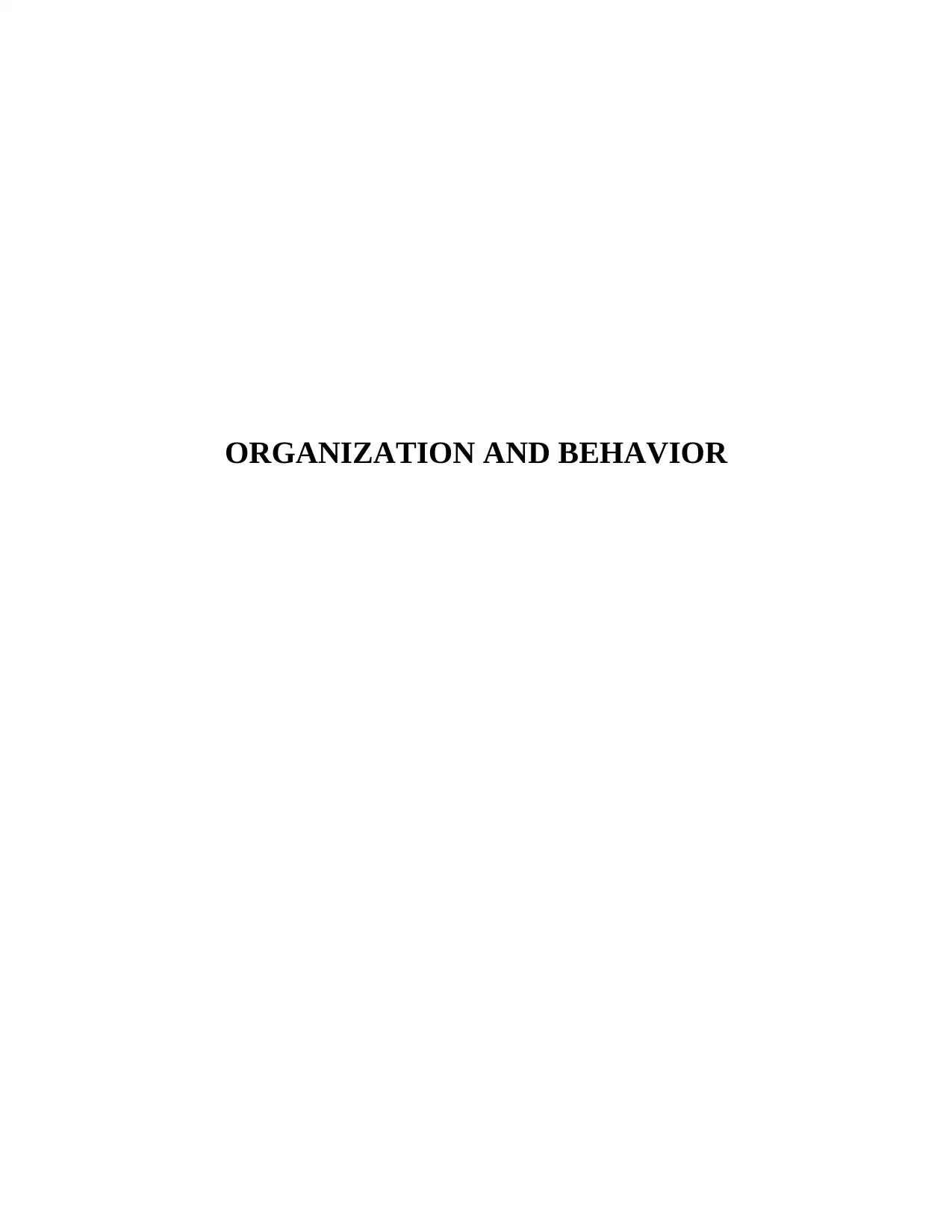
ORGANIZATION AND BEHAVIOR
Paraphrase This Document
Need a fresh take? Get an instant paraphrase of this document with our AI Paraphraser
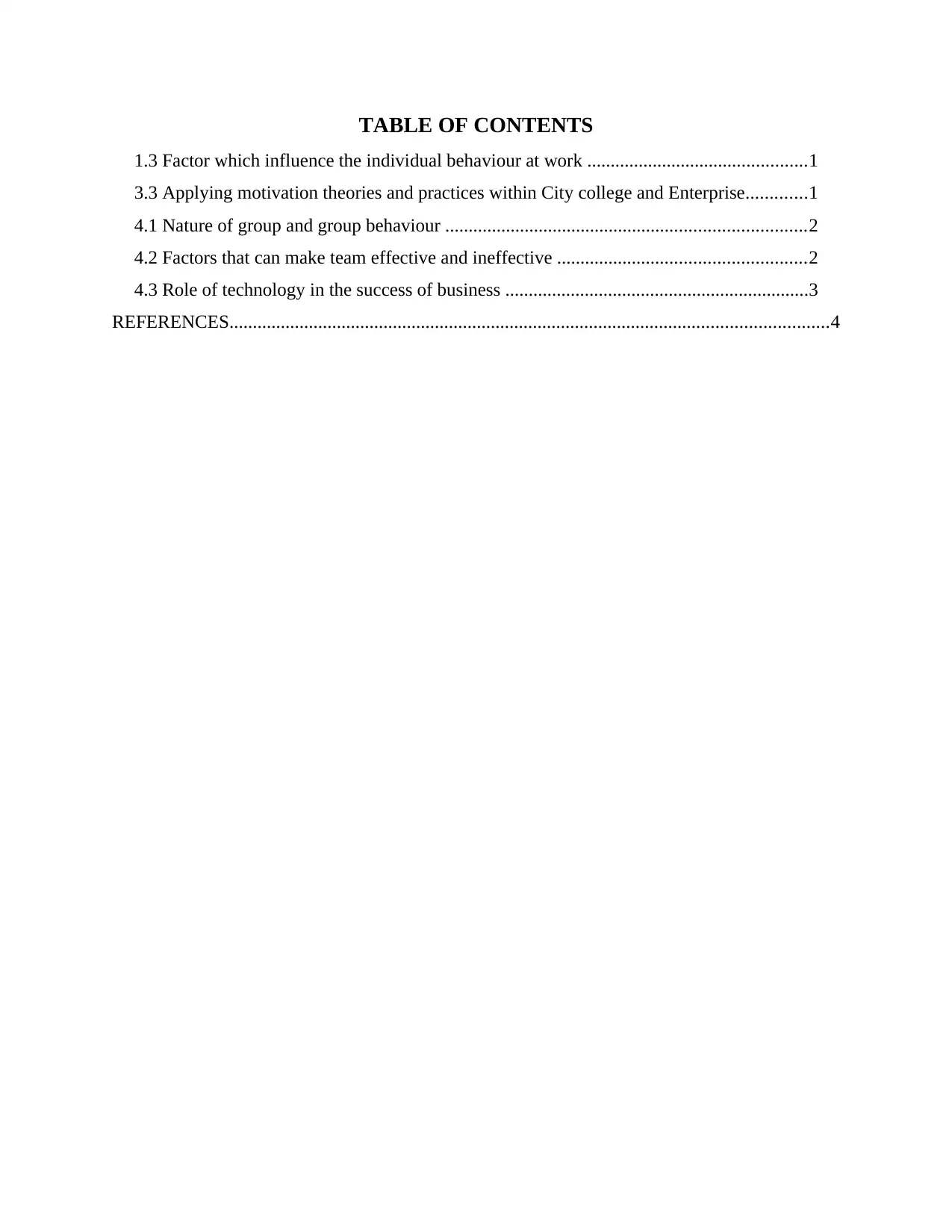
TABLE OF CONTENTS
1.3 Factor which influence the individual behaviour at work ...............................................1
3.3 Applying motivation theories and practices within City college and Enterprise.............1
4.1 Nature of group and group behaviour .............................................................................2
4.2 Factors that can make team effective and ineffective .....................................................2
4.3 Role of technology in the success of business .................................................................3
REFERENCES................................................................................................................................4
1.3 Factor which influence the individual behaviour at work ...............................................1
3.3 Applying motivation theories and practices within City college and Enterprise.............1
4.1 Nature of group and group behaviour .............................................................................2
4.2 Factors that can make team effective and ineffective .....................................................2
4.3 Role of technology in the success of business .................................................................3
REFERENCES................................................................................................................................4
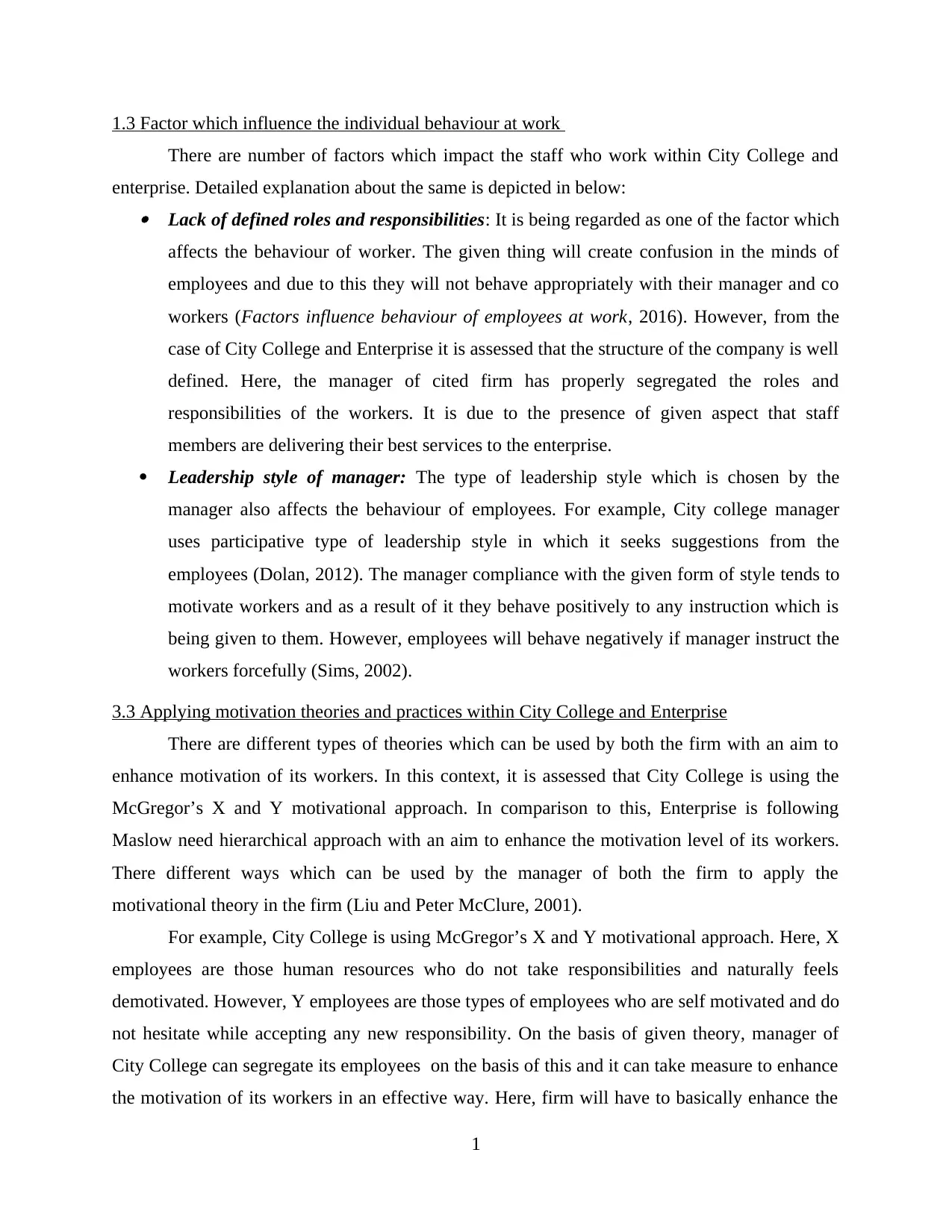
1.3 Factor which influence the individual behaviour at work
There are number of factors which impact the staff who work within City College and
enterprise. Detailed explanation about the same is depicted in below: Lack of defined roles and responsibilities: It is being regarded as one of the factor which
affects the behaviour of worker. The given thing will create confusion in the minds of
employees and due to this they will not behave appropriately with their manager and co
workers (Factors influence behaviour of employees at work, 2016). However, from the
case of City College and Enterprise it is assessed that the structure of the company is well
defined. Here, the manager of cited firm has properly segregated the roles and
responsibilities of the workers. It is due to the presence of given aspect that staff
members are delivering their best services to the enterprise.
Leadership style of manager: The type of leadership style which is chosen by the
manager also affects the behaviour of employees. For example, City college manager
uses participative type of leadership style in which it seeks suggestions from the
employees (Dolan, 2012). The manager compliance with the given form of style tends to
motivate workers and as a result of it they behave positively to any instruction which is
being given to them. However, employees will behave negatively if manager instruct the
workers forcefully (Sims, 2002).
3.3 Applying motivation theories and practices within City College and Enterprise
There are different types of theories which can be used by both the firm with an aim to
enhance motivation of its workers. In this context, it is assessed that City College is using the
McGregor’s X and Y motivational approach. In comparison to this, Enterprise is following
Maslow need hierarchical approach with an aim to enhance the motivation level of its workers.
There different ways which can be used by the manager of both the firm to apply the
motivational theory in the firm (Liu and Peter McClure, 2001).
For example, City College is using McGregor’s X and Y motivational approach. Here, X
employees are those human resources who do not take responsibilities and naturally feels
demotivated. However, Y employees are those types of employees who are self motivated and do
not hesitate while accepting any new responsibility. On the basis of given theory, manager of
City College can segregate its employees on the basis of this and it can take measure to enhance
the motivation of its workers in an effective way. Here, firm will have to basically enhance the
1
There are number of factors which impact the staff who work within City College and
enterprise. Detailed explanation about the same is depicted in below: Lack of defined roles and responsibilities: It is being regarded as one of the factor which
affects the behaviour of worker. The given thing will create confusion in the minds of
employees and due to this they will not behave appropriately with their manager and co
workers (Factors influence behaviour of employees at work, 2016). However, from the
case of City College and Enterprise it is assessed that the structure of the company is well
defined. Here, the manager of cited firm has properly segregated the roles and
responsibilities of the workers. It is due to the presence of given aspect that staff
members are delivering their best services to the enterprise.
Leadership style of manager: The type of leadership style which is chosen by the
manager also affects the behaviour of employees. For example, City college manager
uses participative type of leadership style in which it seeks suggestions from the
employees (Dolan, 2012). The manager compliance with the given form of style tends to
motivate workers and as a result of it they behave positively to any instruction which is
being given to them. However, employees will behave negatively if manager instruct the
workers forcefully (Sims, 2002).
3.3 Applying motivation theories and practices within City College and Enterprise
There are different types of theories which can be used by both the firm with an aim to
enhance motivation of its workers. In this context, it is assessed that City College is using the
McGregor’s X and Y motivational approach. In comparison to this, Enterprise is following
Maslow need hierarchical approach with an aim to enhance the motivation level of its workers.
There different ways which can be used by the manager of both the firm to apply the
motivational theory in the firm (Liu and Peter McClure, 2001).
For example, City College is using McGregor’s X and Y motivational approach. Here, X
employees are those human resources who do not take responsibilities and naturally feels
demotivated. However, Y employees are those types of employees who are self motivated and do
not hesitate while accepting any new responsibility. On the basis of given theory, manager of
City College can segregate its employees on the basis of this and it can take measure to enhance
the motivation of its workers in an effective way. Here, firm will have to basically enhance the
1
⊘ This is a preview!⊘
Do you want full access?
Subscribe today to unlock all pages.

Trusted by 1+ million students worldwide
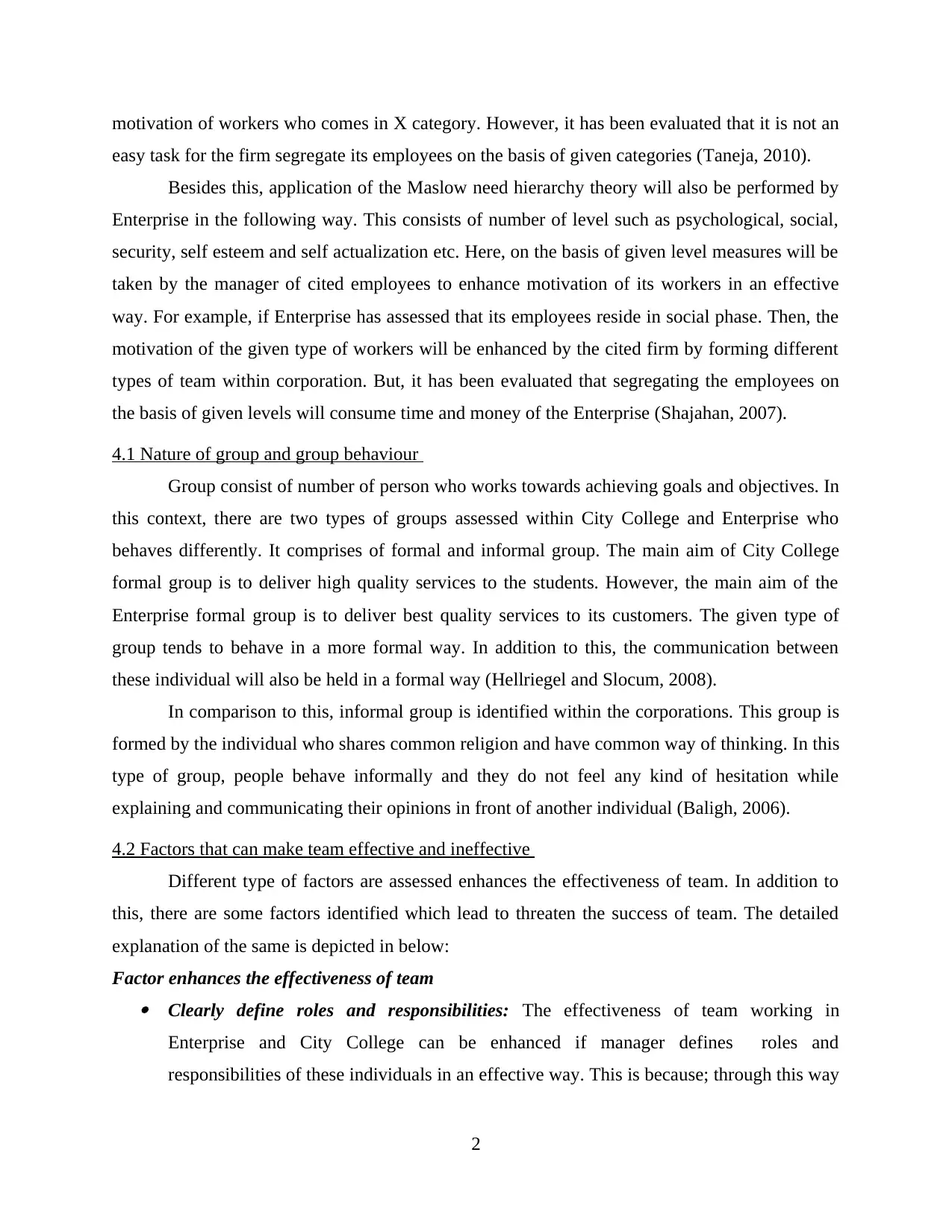
motivation of workers who comes in X category. However, it has been evaluated that it is not an
easy task for the firm segregate its employees on the basis of given categories (Taneja, 2010).
Besides this, application of the Maslow need hierarchy theory will also be performed by
Enterprise in the following way. This consists of number of level such as psychological, social,
security, self esteem and self actualization etc. Here, on the basis of given level measures will be
taken by the manager of cited employees to enhance motivation of its workers in an effective
way. For example, if Enterprise has assessed that its employees reside in social phase. Then, the
motivation of the given type of workers will be enhanced by the cited firm by forming different
types of team within corporation. But, it has been evaluated that segregating the employees on
the basis of given levels will consume time and money of the Enterprise (Shajahan, 2007).
4.1 Nature of group and group behaviour
Group consist of number of person who works towards achieving goals and objectives. In
this context, there are two types of groups assessed within City College and Enterprise who
behaves differently. It comprises of formal and informal group. The main aim of City College
formal group is to deliver high quality services to the students. However, the main aim of the
Enterprise formal group is to deliver best quality services to its customers. The given type of
group tends to behave in a more formal way. In addition to this, the communication between
these individual will also be held in a formal way (Hellriegel and Slocum, 2008).
In comparison to this, informal group is identified within the corporations. This group is
formed by the individual who shares common religion and have common way of thinking. In this
type of group, people behave informally and they do not feel any kind of hesitation while
explaining and communicating their opinions in front of another individual (Baligh, 2006).
4.2 Factors that can make team effective and ineffective
Different type of factors are assessed enhances the effectiveness of team. In addition to
this, there are some factors identified which lead to threaten the success of team. The detailed
explanation of the same is depicted in below:
Factor enhances the effectiveness of team Clearly define roles and responsibilities: The effectiveness of team working in
Enterprise and City College can be enhanced if manager defines roles and
responsibilities of these individuals in an effective way. This is because; through this way
2
easy task for the firm segregate its employees on the basis of given categories (Taneja, 2010).
Besides this, application of the Maslow need hierarchy theory will also be performed by
Enterprise in the following way. This consists of number of level such as psychological, social,
security, self esteem and self actualization etc. Here, on the basis of given level measures will be
taken by the manager of cited employees to enhance motivation of its workers in an effective
way. For example, if Enterprise has assessed that its employees reside in social phase. Then, the
motivation of the given type of workers will be enhanced by the cited firm by forming different
types of team within corporation. But, it has been evaluated that segregating the employees on
the basis of given levels will consume time and money of the Enterprise (Shajahan, 2007).
4.1 Nature of group and group behaviour
Group consist of number of person who works towards achieving goals and objectives. In
this context, there are two types of groups assessed within City College and Enterprise who
behaves differently. It comprises of formal and informal group. The main aim of City College
formal group is to deliver high quality services to the students. However, the main aim of the
Enterprise formal group is to deliver best quality services to its customers. The given type of
group tends to behave in a more formal way. In addition to this, the communication between
these individual will also be held in a formal way (Hellriegel and Slocum, 2008).
In comparison to this, informal group is identified within the corporations. This group is
formed by the individual who shares common religion and have common way of thinking. In this
type of group, people behave informally and they do not feel any kind of hesitation while
explaining and communicating their opinions in front of another individual (Baligh, 2006).
4.2 Factors that can make team effective and ineffective
Different type of factors are assessed enhances the effectiveness of team. In addition to
this, there are some factors identified which lead to threaten the success of team. The detailed
explanation of the same is depicted in below:
Factor enhances the effectiveness of team Clearly define roles and responsibilities: The effectiveness of team working in
Enterprise and City College can be enhanced if manager defines roles and
responsibilities of these individuals in an effective way. This is because; through this way
2
Paraphrase This Document
Need a fresh take? Get an instant paraphrase of this document with our AI Paraphraser
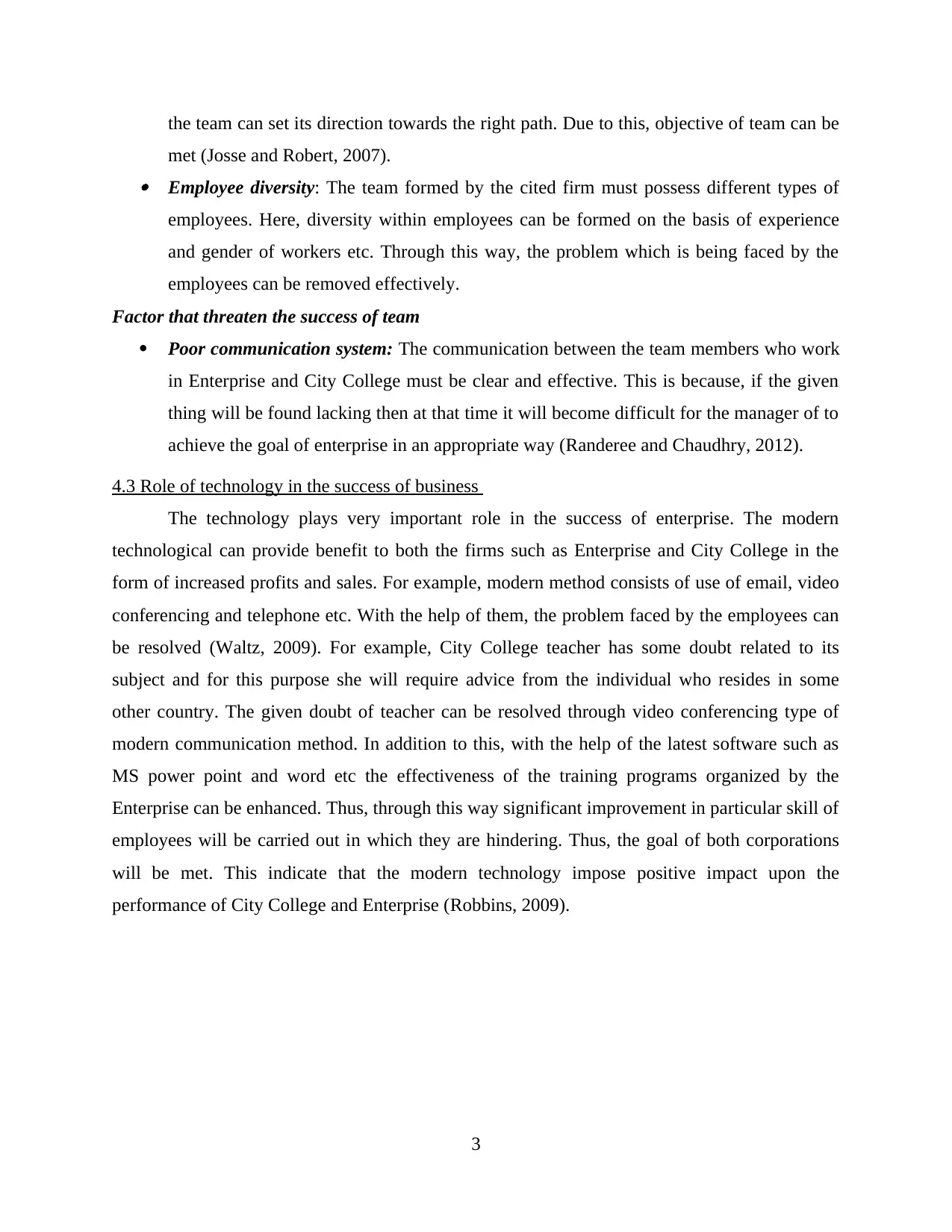
the team can set its direction towards the right path. Due to this, objective of team can be
met (Josse and Robert, 2007). Employee diversity: The team formed by the cited firm must possess different types of
employees. Here, diversity within employees can be formed on the basis of experience
and gender of workers etc. Through this way, the problem which is being faced by the
employees can be removed effectively.
Factor that threaten the success of team
Poor communication system: The communication between the team members who work
in Enterprise and City College must be clear and effective. This is because, if the given
thing will be found lacking then at that time it will become difficult for the manager of to
achieve the goal of enterprise in an appropriate way (Randeree and Chaudhry, 2012).
4.3 Role of technology in the success of business
The technology plays very important role in the success of enterprise. The modern
technological can provide benefit to both the firms such as Enterprise and City College in the
form of increased profits and sales. For example, modern method consists of use of email, video
conferencing and telephone etc. With the help of them, the problem faced by the employees can
be resolved (Waltz, 2009). For example, City College teacher has some doubt related to its
subject and for this purpose she will require advice from the individual who resides in some
other country. The given doubt of teacher can be resolved through video conferencing type of
modern communication method. In addition to this, with the help of the latest software such as
MS power point and word etc the effectiveness of the training programs organized by the
Enterprise can be enhanced. Thus, through this way significant improvement in particular skill of
employees will be carried out in which they are hindering. Thus, the goal of both corporations
will be met. This indicate that the modern technology impose positive impact upon the
performance of City College and Enterprise (Robbins, 2009).
3
met (Josse and Robert, 2007). Employee diversity: The team formed by the cited firm must possess different types of
employees. Here, diversity within employees can be formed on the basis of experience
and gender of workers etc. Through this way, the problem which is being faced by the
employees can be removed effectively.
Factor that threaten the success of team
Poor communication system: The communication between the team members who work
in Enterprise and City College must be clear and effective. This is because, if the given
thing will be found lacking then at that time it will become difficult for the manager of to
achieve the goal of enterprise in an appropriate way (Randeree and Chaudhry, 2012).
4.3 Role of technology in the success of business
The technology plays very important role in the success of enterprise. The modern
technological can provide benefit to both the firms such as Enterprise and City College in the
form of increased profits and sales. For example, modern method consists of use of email, video
conferencing and telephone etc. With the help of them, the problem faced by the employees can
be resolved (Waltz, 2009). For example, City College teacher has some doubt related to its
subject and for this purpose she will require advice from the individual who resides in some
other country. The given doubt of teacher can be resolved through video conferencing type of
modern communication method. In addition to this, with the help of the latest software such as
MS power point and word etc the effectiveness of the training programs organized by the
Enterprise can be enhanced. Thus, through this way significant improvement in particular skill of
employees will be carried out in which they are hindering. Thus, the goal of both corporations
will be met. This indicate that the modern technology impose positive impact upon the
performance of City College and Enterprise (Robbins, 2009).
3
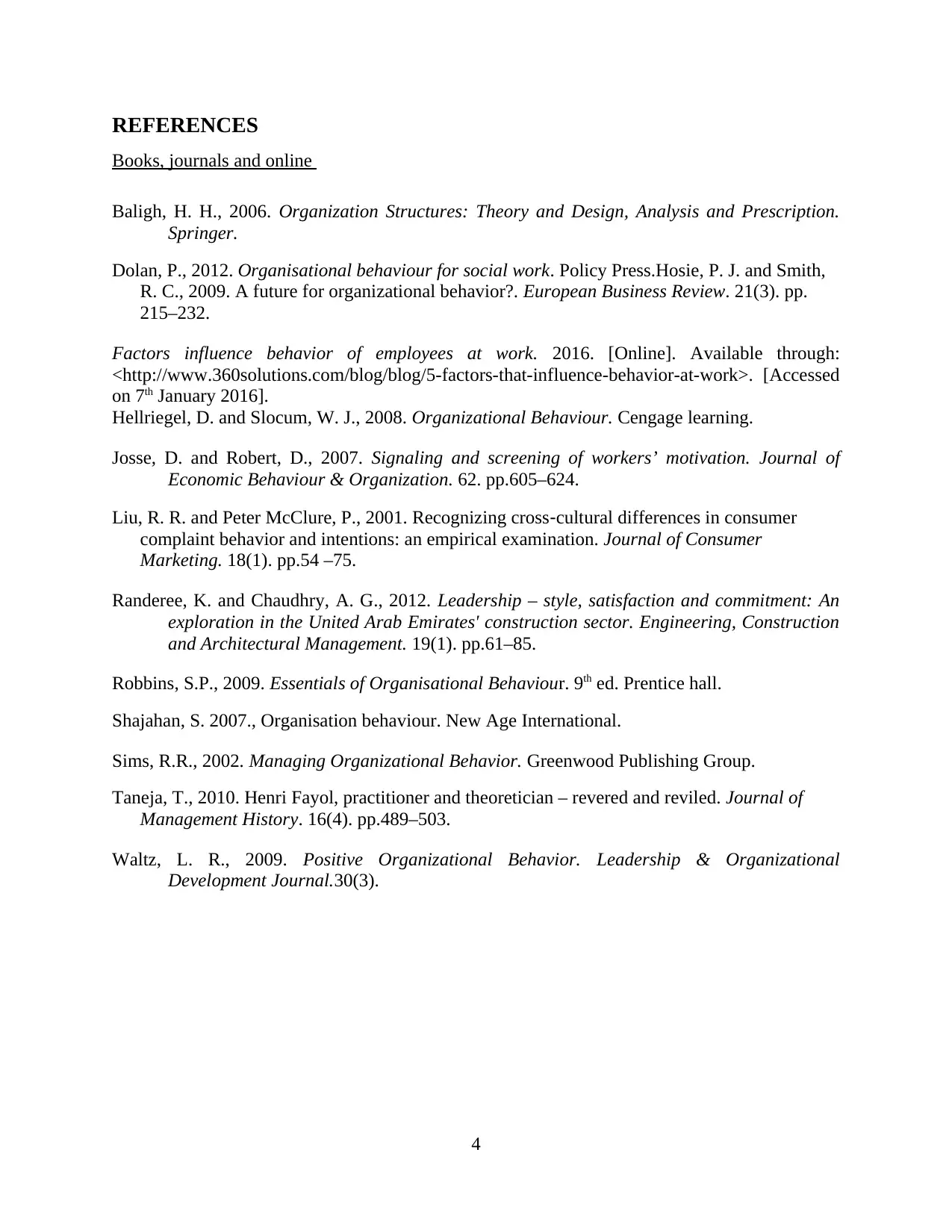
REFERENCES
Books, journals and online
Baligh, H. H., 2006. Organization Structures: Theory and Design, Analysis and Prescription.
Springer.
Dolan, P., 2012. Organisational behaviour for social work. Policy Press.Hosie, P. J. and Smith,
R. C., 2009. A future for organizational behavior?. European Business Review. 21(3). pp.
215–232.
Factors influence behavior of employees at work. 2016. [Online]. Available through:
<http://www.360solutions.com/blog/blog/5-factors-that-influence-behavior-at-work>. [Accessed
on 7th January 2016].
Hellriegel, D. and Slocum, W. J., 2008. Organizational Behaviour. Cengage learning.
Josse, D. and Robert, D., 2007. Signaling and screening of workers’ motivation. Journal of
Economic Behaviour & Organization. 62. pp.605–624.
Liu, R. R. and Peter McClure, P., 2001. Recognizing cross‐cultural differences in consumer
complaint behavior and intentions: an empirical examination. Journal of Consumer
Marketing. 18(1). pp.54 –75.
Randeree, K. and Chaudhry, A. G., 2012. Leadership – style, satisfaction and commitment: An
exploration in the United Arab Emirates' construction sector. Engineering, Construction
and Architectural Management. 19(1). pp.61–85.
Robbins, S.P., 2009. Essentials of Organisational Behaviour. 9th ed. Prentice hall.
Shajahan, S. 2007., Organisation behaviour. New Age International.
Sims, R.R., 2002. Managing Organizational Behavior. Greenwood Publishing Group.
Taneja, T., 2010. Henri Fayol, practitioner and theoretician – revered and reviled. Journal of
Management History. 16(4). pp.489–503.
Waltz, L. R., 2009. Positive Organizational Behavior. Leadership & Organizational
Development Journal.30(3).
4
Books, journals and online
Baligh, H. H., 2006. Organization Structures: Theory and Design, Analysis and Prescription.
Springer.
Dolan, P., 2012. Organisational behaviour for social work. Policy Press.Hosie, P. J. and Smith,
R. C., 2009. A future for organizational behavior?. European Business Review. 21(3). pp.
215–232.
Factors influence behavior of employees at work. 2016. [Online]. Available through:
<http://www.360solutions.com/blog/blog/5-factors-that-influence-behavior-at-work>. [Accessed
on 7th January 2016].
Hellriegel, D. and Slocum, W. J., 2008. Organizational Behaviour. Cengage learning.
Josse, D. and Robert, D., 2007. Signaling and screening of workers’ motivation. Journal of
Economic Behaviour & Organization. 62. pp.605–624.
Liu, R. R. and Peter McClure, P., 2001. Recognizing cross‐cultural differences in consumer
complaint behavior and intentions: an empirical examination. Journal of Consumer
Marketing. 18(1). pp.54 –75.
Randeree, K. and Chaudhry, A. G., 2012. Leadership – style, satisfaction and commitment: An
exploration in the United Arab Emirates' construction sector. Engineering, Construction
and Architectural Management. 19(1). pp.61–85.
Robbins, S.P., 2009. Essentials of Organisational Behaviour. 9th ed. Prentice hall.
Shajahan, S. 2007., Organisation behaviour. New Age International.
Sims, R.R., 2002. Managing Organizational Behavior. Greenwood Publishing Group.
Taneja, T., 2010. Henri Fayol, practitioner and theoretician – revered and reviled. Journal of
Management History. 16(4). pp.489–503.
Waltz, L. R., 2009. Positive Organizational Behavior. Leadership & Organizational
Development Journal.30(3).
4
⊘ This is a preview!⊘
Do you want full access?
Subscribe today to unlock all pages.

Trusted by 1+ million students worldwide
1 out of 6
Related Documents
Your All-in-One AI-Powered Toolkit for Academic Success.
+13062052269
info@desklib.com
Available 24*7 on WhatsApp / Email
![[object Object]](/_next/static/media/star-bottom.7253800d.svg)
Unlock your academic potential
Copyright © 2020–2025 A2Z Services. All Rights Reserved. Developed and managed by ZUCOL.





